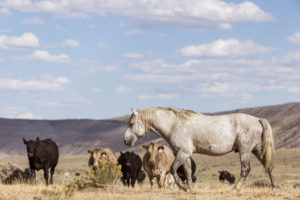For Immediate Release
November 25, 2019
Contact:
Scott Lake, Western Watersheds Project, (208) 429-1679, scott@westernwatersheds.org
BOISE, Ida. — Western Watersheds Project filed formal comments yesterday objecting to a plan by the Bureau of Land Management (BLM) to slice over a thousand miles of fuel breaks through sagebrush habitats in southeastern Oregon and southwestern Idaho. The Tri-State fuel breaks proposal would authorize program of mowing, burning, and high-intensity livestock grazing across 3.6 million acres over 10 to 15 years, fragmenting some of the most important wildlife habitat in the interior West. The proposal also includes an ambitious road building and maintenance program that would impact the area for decades to come.
“Fuel breaks and roads harm wildlife by spreading invasive species and fragmenting habitat,” said Scott Lake, Idaho Director for Western Watersheds Project. “This project won’t stop the kind of large, fast-burning, wind-driven fires that are threatening the sagebrush steppe, but it will spread invasive grasses, which fuel larger, more frequent fires.”
According to the U.S. Geological Survey, there is little evidence that fuel breaks are effective at controlling or even slowing large wildfires. Most of the argumentation for fuel breaks’ effectiveness consists of selective, anecdotal accounts that are impossible to verify or empirically analyze. On the other hand, most large fires occur during extremely hot, dry periods with high winds, conditions under which fuel breaks provide little defense.
Invasive grasses such as cheatgrass and medusahead wildrye thrive on ground disturbance and overgrazing. Studies have shown that fuel break construction—which can involve mowing, seeding, burning, and heavy livestock grazing—favors these species and can increase wildfire risk over the long-term. The Tri-State proposal would also dramatically increase motorized access into some of the most remote wildlife habitats in the West. Motorized access and recreation have been identified as a leading threat to sage-grouse and other sage-steppe wildlife.
“The science on fire, weeds, and sage-grouse has been clear for years, BLM just needs to follow it,” Lake said. “Instead of expensive, ineffective, and harmful fuel breaks, BLM should be protecting the public lands from livestock, ORVs, and other human-caused sources of disturbance. In devising the massive Tri-State fuel break network, BLM is proposing 19th-century solutions to 21st century problems.”
BLM’s environmental analysis for the Tri-State project largely ignores the impacts of current land uses such as livestock grazing and off-road vehicle (ORV) use. However, these widespread and largely unregulated activities are the root causes of the problems BLM is trying to address. For instance, most of the grazing allotments assessed in the Tri-State area are failing to meet the agency’s basic rangeland health standards, and this is largely due to current livestock grazing impacts. Grazing has been strongly linked to cheatgrass invasions on public land.






